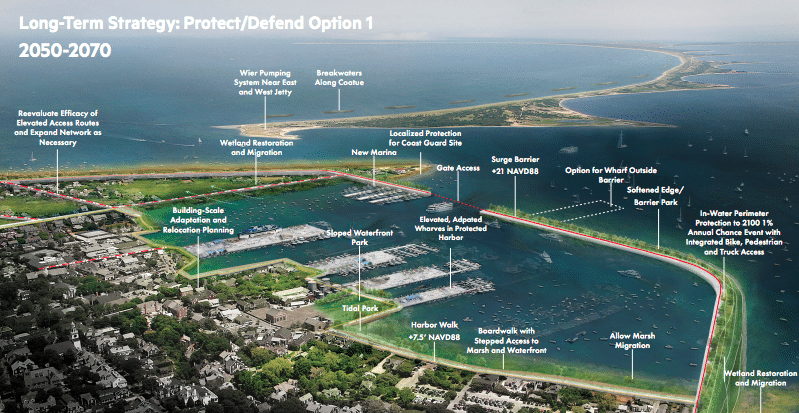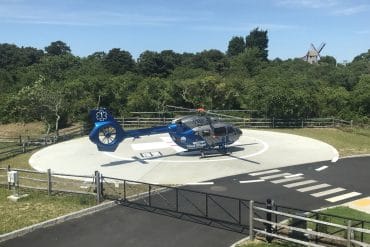As a fall nor’easter flooded parts of downtown Nantucket at high tide on Wednesday, the town’s final Coastal Resilience Plan was released.
The timing wasn’t intentional, but the coincidence underscored the importance of the document, which provides a roadmap for the island to mitigate the impacts of sea level rise and erosion in the decades ahead.
Checking in at 286 pages, the final report is big, as are the challenges it outlines, and the estimated costs of the solutions it recommends. With 4.3 feet of sea level rise anticipated by 2070 and billions of dollars in public and private property at risk, the plan proposes 40 projects around the island, including raising roads and wharves, dune restoration, sand pumping and bypass systems, as well as a downtown flood barrier. The price tag? As much as $900 million.
The members of the Coastal Resilience Advisory Committee, which assisted in drafting the plan with the town’s consultant Arcadis, understand that’s a daunting number to contemplate. But with the plan now finalized, they said, it’s time to digest its contents, present it to the Select Board and the community, and then consider how to prioritize areas of the island as well as the strategies identified to protect them.
“This is not a railroad track where we get the plan and start implementing the recommendations immediately,” said Mary Longacre, the chair of the Coastal Resilience Advisory Committee. “This is more of a wake-up call. If we’re going to protect the entire island from the erosion and flooding we expect to have happen, it would be a tremendous undertaking. That opens the door to evaluating the highest priorities for us as a community. What do we need to start protecting right away?”
Vincent Murphy, the town’s coastal resiliency coordinator, acknowledged the cost estimates attached to the plan are intimidating, but emphasized the projects would be funded over a period of 30 years, and the scale of the properties and infrastructure around the island that are at risk from sea level rise and erosion.
“You end up with very high numbers if you add everything up, and what that kind of massive figure is trying to capture – let’s say you round it up to $1 billion and everything is going to get implemented on a timeline of 30 to 50 years – the plan also says over the next 50 years we can expect $3.4 billion in losses,” Murphy said. “So you can break it out in a different way: for every dollar spent on this, you end up with $2.50 in savings.”
Even before the cost estimates were released in the final report on Wednesday, committee members had already discussed a number of potential funding sources to pay for expensive coastal resiliency projects. They include everything from state and federal grants, to betterment fees levied on property owners that would directly benefit from a coastal resilience initiative, as well as private fundraising efforts, a new real estate transfer tax, and spreading it across the tax base.
Murphy said a project like the downtown flood barrier, which could cost $150 million to $170 million, would be “very likely” to receive as much as 75 percent of its funding from state or federal grants for coastal resiliency projects. Even though communities up and down the East Coast will be seeking the same funding in the years to come, Murphy said the fact that Nantucket has already completed its coastal resilience plan puts the island in an advantageous position.
“We’re ahead of the curve now in having a coastal resilience plan,” Murphy said. “There are other communities that are nowhere near this stage. There are big cities ahead of us so to speak, places like Boston and New York, they have big populations with very large areas to protect, so yes we’re going to be competing with them. But even as a small community, we’re on par because we have the coastal resilience plan.”
The Coastal Resiliency Advisory Committee will meet next Tuesday, Nov. 2, to discuss the final plan. At some point, its members will vote to either accept or reject the document, after which it will go to the Select Board for a similar review and adoption process.






